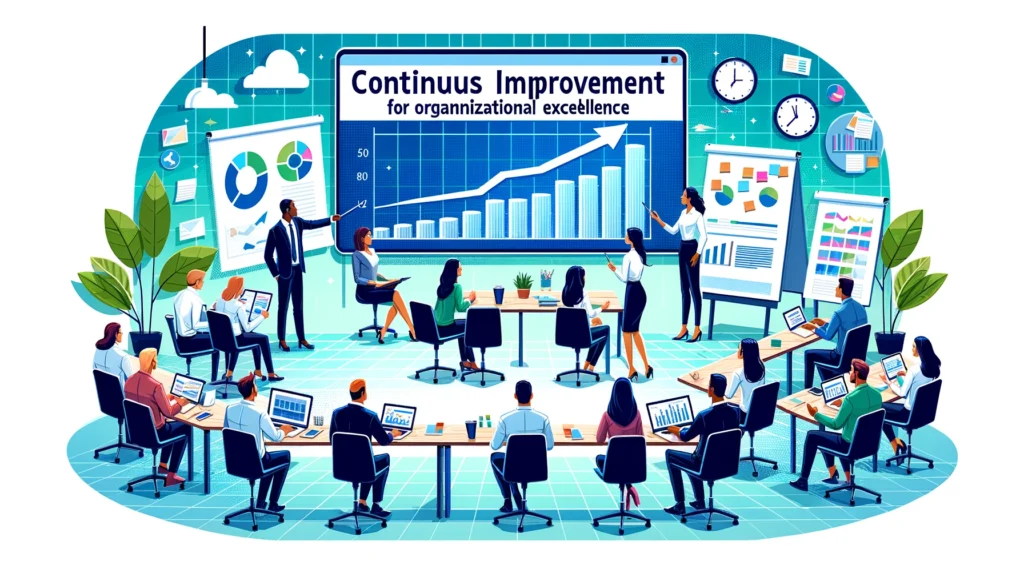
Leveraging Automation for Efficiency
As the digital landscape continues to evolve, it becomes increasingly important for individuals and organizations to keep pace with emerging trends. One of the most prominent developments is the increased adoption of automation in various aspects of work and life. Automation, particularly in repetitive tasks, streamlines processes, increases efficiency, and reduces errors.
Table of Contents
Importance of Automation
According to a survey by UiPath, 96% of organizations believe automation is critical to their digital transformation efforts. This is because automation can address several inefficiencies that plague organizations today.
Outdated technology, for instance, is listed as one of the inefficient business processes affecting companies. Automating repetitive tasks reduces manual errors, saves time and energy, and improves customer experience. Automated processes are often faster and more efficient than manual ones, leading to significant improvements in productivity and wellbeing.
Benefits of Automation
Automation brings a multitude of benefits. Around 60% of jobs have one-third of tasks that can be automated, according to a study by McKinsey (Cflow Apps). Tasks such as data entry, backup and file management, email management, report generation, billing and invoicing, and social media management can be automated, leading to increased productivity, reduced errors, improved employee engagement, cost savings, improved quality and customer experience, better resource allocation, better decision-making, scalability, and innovation.
Embracing automation can help reduce high operational costs in comparison to manual processes within a company. Hence, automation not only improves efficiency but also contributes significantly to cost savings.
Tools for Automation
There are various tools available to automate repetitive tasks, ranging from basic task schedulers to advanced Artificial Intelligence (AI) solutions. These process improvement tools enable organizations to systematically evaluate their processes and enact effective solutions by providing them with data and insights (Document360).
By identifying bottlenecks, redundancies, and unplanned outages within organizational procedures, these tools help streamline operations, minimize loss, and enhance efficiency, fostering organizational growth (Document360).
Automation is a powerful strategy for improving efficiency with technology. By automating repetitive tasks, individuals and organizations can save time, reduce errors, and focus on more strategic and rewarding tasks. For more insights on leveraging digital solutions for productivity, check out our article on improving productivity with digital tools.

Enhancing Administrative Tasks with Technology
Technology plays an increasingly important role in improving efficiency and productivity in managing administrative tasks. Leveraging the right digital solutions can help streamline workflow, automate repetitive tasks, and enhance learning and development opportunities.
Streamlining Communication
Effective communication is key to managing administrative tasks smoothly. Technology tools such as Slack, Teams, Asana, Google Translate, Linguee, or Reverso can significantly simplify communication. They consolidate and organize messages, facilitate real-time conversations, file sharing, task management, and project collaboration, making it easier to maintain clear and consistent communication with stakeholders (LinkedIn).
These tools integrate seamlessly with other digital solutions for productivity, providing a comprehensive platform for managing all aspects of administrative tasks. From translating messages to organizing team conversations, these tools bring all communication channels into one place for improved efficiency.
Optimizing Time Management
Time management is another crucial aspect of administrative tasks that can be optimized through technology. Tools like Toggl, RescueTime, Clockify, Google Calendar, Outlook, Calendly, Trello, Basecamp, or Wrike are designed to track, schedule, delegate tasks, and prioritize activities. These tools provide insights into how time is spent and help improve productivity by identifying areas where time can be better utilized.
By leveraging these digital tools for time management, administrative tasks can be managed more efficiently, freeing up time for other important tasks and improving overall productivity.
Simplifying Learning and Development
Technology also plays a critical role in enhancing learning and development opportunities. Platforms such as Coursera, Udemy, Skillshare, LinkedIn, Medium, or Quora provide access to free or low-cost online courses, webinars, workshops, and expert insights on various topics and skills.
These platforms provide flexible and accessible learning opportunities, allowing individuals to continuously improve their skills and knowledge. This not only enhances personal development but also contributes to overall productivity and efficiency in managing administrative tasks.
In sum, by integrating and leveraging technology for wellbeing, individuals can significantly improve their efficiency and productivity in managing administrative tasks. From streamlining communication to optimizing time management and enhancing learning and development, digital solutions provide effective tools for improving efficiency with technology. This, in turn, contributes to improved productivity and wellbeing.

The Role of AI in Improving Efficiency
Artificial intelligence (AI) is increasingly becoming a key player in enhancing productivity and efficiency, particularly in the business world. As companies aim to optimize their operations, AI has shown significant promise in revolutionizing processes and systems.
AI in Process Improvement
AI has the potential to drastically improve business efficiency. According to a recent survey by McKinsey & Company, AI can boost business efficiency by up to 40% and decrease operational costs by as much as 30%.
This improvement in efficiency can be attributed to AI’s ability to automate and streamline various business processes, particularly those that are time-consuming or require extensive data processing. By automating these tasks, businesses can save significant time and resources, allowing them to focus on more strategic initiatives. This ability to streamline operations can be an essential element in improving productivity with digital tools.
Furthermore, AI can free up employees’ time from repetitive tasks, enabling them to concentrate on more complex tasks that require human skills like problem-solving and creativity. This shift in task management can not only enhance efficiency but also potentially alleviate job loss concerns associated with automation.
Implementing AI Solutions
When considering the implementation of AI, businesses should focus on identifying specific processes that can benefit from AI. This could include tasks that are time-consuming, those that require large amounts of data processing, or tasks that could be more accurately completed with the assistance of AI.
For example, a manufacturing company could leverage AI to automate its inventory management system. This could lead to a reduction in the risk of overstocking or stockouts and a reduction in carrying costs, thus contributing to cost savings and improved efficiency.
Overcoming Challenges with AI
While the potential benefits of AI in improving efficiency are significant, it’s essential to also consider the potential challenges. For instance, transparency and accountability are crucial in AI decision-making processes to address potential biases and unintended consequences from historical data used to train AI systems in the workplace.
To overcome these challenges, businesses should prioritize open communication about their AI initiatives and provide training for employees to understand how AI works and how it can be used responsibly. This can help to foster trust in AI systems and ensure their effective and ethical use in the workplace.
By understanding and addressing these challenges, businesses can harness the true power of AI in improving efficiency with technology, maximizing their productivity, and enhancing their competitive advantage.

Cost-Saving Strategies with Technology
The utilization of digital solutions can significantly aid in improving efficiency with technology, leading to substantial cost savings. In this section, we’ll delve into the impact of automation, the benefits of cloud computing, and the strategic use of data analytics in driving cost efficiency.
Automation for Cost Efficiency
Automation serves as an effective tool to leverage technology for cost savings by eliminating time-consuming and error-prone manual tasks. For instance, a manufacturing company can automate its inventory management system, reducing the risk of overstocking or stockouts and minimizing carrying costs Source. Automation also aids in improving productivity with digital tools, thus enhancing operational efficiency. According to a survey by McKinsey, AI can improve business efficiency by up to 40% and reduce operational costs by up to 30% McKinsey & Company.
Cloud Computing Benefits
Cloud computing can revolutionize the way businesses store and process data, reducing reliance on expensive on-premises infrastructure and hardware. Cloud-based solutions also offer scalability, allowing businesses to pay only for the resources they need Source. For example, a small e-commerce startup can leverage cloud-based customer relationship management (CRM) software instead of investing in costly servers and software licenses. Cloud computing is a key aspect of leveraging technology for wellbeing as it allows for flexibility and remote access, enhancing work-life balance.
Data Analytics for Informed Decisions
Data analytics tools can help businesses identify inefficiencies, optimize processes, and make informed decisions. This strategic use of data is a vital part of digital solutions for productivity. For instance, a retail chain can analyze sales data to determine the most profitable product lines and reduce inventory holding costs for underperforming items Source.
Data analytics also play a crucial role in identifying trends and forecasting future scenarios, enabling businesses to plan strategically and stay ahead of the competition. By leveraging data-driven insights, companies can make more informed decisions, optimize resources, and ultimately improve their bottom line.
Through the strategic use of automation, cloud computing, and data analytics, businesses can drastically improve their efficiency and realize significant cost savings. These digital solutions not only enhance productivity but also foster a culture of innovation and continuous improvement.

Continuous Improvement for Organizational Excellence
In a world where efficiency and productivity are key, organizations are increasingly turning to digital solutions to streamline processes and improve overall performance. This section will explore some of the tools and strategies that can be used to foster a culture of continuous improvement within an organization.
Process Improvement Tools
Process improvement tools encompass a range of approaches that aim to identify, analyze, and implement changes to boost operational efficiency, minimize loss, and improve overall quality and performance (Document360). These tools enable organizations to systematically evaluate their processes and enact effective solutions by providing them with data and insights.
By identifying bottlenecks, redundancies, and unplanned outages within organizational procedures, these tools can help streamline operations, minimize loss, and enhance efficiency, fostering organizational growth. Moreover, they can minimize errors and defects by systematically identifying potential pitfalls within operational workflows (Document360).
For more on how technology can enhance productivity, see our article on improving productivity with digital tools.
PDSA Cycle for Continuous Improvement
The PDSA cycle (Plan, Do, Study, Act) is a four-step iterative problem-solving and continuous improvement framework. It provides a systematic approach for testing and implementing changes to improve processes, products, or services.
The cycle begins with planning, where the team identifies a problem and develops a plan to solve it. Next, the plan is implemented, and the results are studied. Based on the findings, the team then acts by either implementing the change on a larger scale or revising the plan and starting the cycle again.
This cycle is a practical tool for any organization looking to make continuous improvements to their processes and strategies. To learn more about efficiency and wellbeing, see our article on leveraging technology for wellbeing.
Continuous Improvement Software
Continuous improvement software, also known as improvement management software or CI software, is a digital tool or platform designed to facilitate and streamline the ongoing improvement process within an organization. It helps manage and track improvement initiatives, capture and analyze data, collaborate on improvement projects, and drive a culture of continuous learning and innovation (KaiNexus).
These tools are essential for organizations that are serious about implementing continuous improvement strategies. They provide a centralized platform for tracking and managing improvement initiatives, ensuring that everyone in the organization is aligned and working towards the same goals. For more on digital solutions that can boost productivity, see our article on digital solutions for productivity.
By leveraging technology and adopting a continuous improvement mindset, organizations can enhance their efficiency, improve their processes, and achieve excellence in their operations. Whether it’s through process improvement tools, the PDSA cycle, or continuous improvement software, the power of automation and technology cannot be understated when it comes to improving efficiency.

Advancements in Employee Training Technology
Improving efficiency with technology has become a core strategy for many organizations, and nowhere is this more evident than in the realm of employee training. With a range of digital solutions at our disposal, businesses are now able to provide personalized training programs, utilize digital adoption platforms, and leverage artificial intelligence in learning management systems.
Personalized Training Programs
Personalized training programs are a significant departure from traditional one-size-fits-all training methods. By utilizing digital training software, businesses can now provide custom learning pathways based on individual needs. This results in more beneficial learning experiences for employees and a more efficient training process overall. By tailoring the training to each individual, employees can focus on areas that are most relevant to them, leading to improved performance and productivity (Forbes).
Digital Adoption Platforms
Digital adoption platforms (DAPs) offer another avenue for enhancing employee training. These platforms integrate with existing digital tools to offer automated training tailored to the user. They provide task lists with relevant walk-throughs and track employees’ learning progress, all while improving overall workflow efficiency. DAPs are a powerful tool for onboarding new employees and upskilling existing staff, ensuring that everyone is fully equipped to utilize digital tools for time management and productivity.
AI in Learning Management Systems
Artificial Intelligence (AI) has become an integral part of many digital learning solutions. AI enhances personalized training programs by determining employees’ roles, creating development goals, adapting training needs, suggesting next steps during training, and customizing courses based on employees’ decisions and actions. This leads to more effective training experiences and improved learning outcomes.
In addition, AI can be leveraged within learning management systems (LMS) to suggest similar courses based on employees’ actions, decisions, and completed courses. This further customizes training to meet individual requirements and improves the overall learning experience (Forbes).
Furthermore, experiential learning coupled with AI allows for monitoring of employees’ on-the-job activities. This data is then analyzed through machine learning, bucketing users based on their familiarity with certain applications, and recommending content tailored to the individual’s learning needs. Such approaches have shown a 6% improvement in content consumption based on internal studies.
These advancements in employee training technology are revolutionizing the way businesses approach employee development. By leveraging technology for wellbeing and productivity, organizations can create more efficient and effective training programs that meet individual needs and drive organizational excellence.


